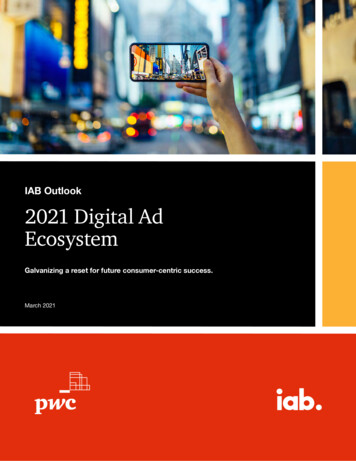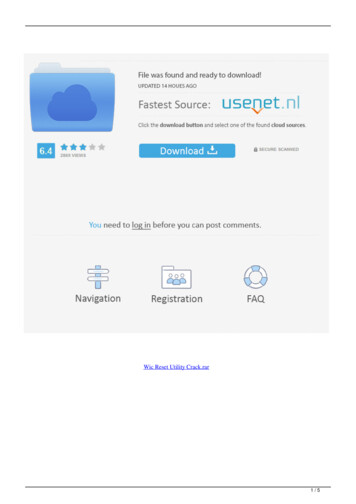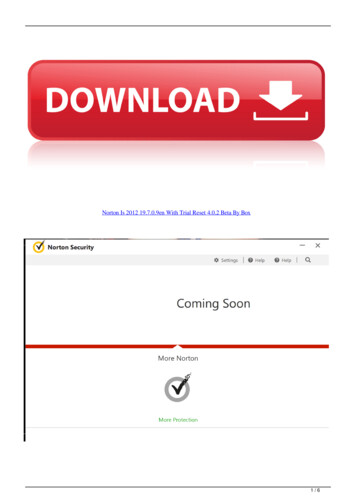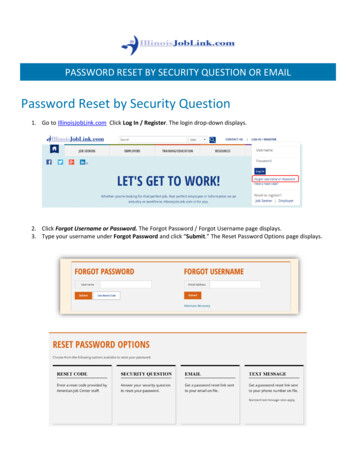
Transcription
IAB Outlook2021 Digital AdEcosystemGalvanizing a reset for future consumer-centric success.March 2021
Table of contentsIntroduction3How and why the advertising-supported digital ecosystem is at an inflectionpoint, and how to prepare for and direct what’s nextMethodology and approach5Section 17-13The consumer in focus Take care of your consumers, or your competitors willDefining what “value” means to consumersThe consumer attention war helps unlock new purchase normsConsumer sentiment watchlist: The growing trust gapSection 214-20Forecasted growth (in a highly fragmented and uncertain environment) Lessons learned from 2020—which new digital behaviors will stick?Risks and opportunities in defining and adopting future consumer identity and attribution modelsNew consumer identity patterns foster a director-to-consumer imperative5G: Innovating digital consumer experienceSection 321-28Unlocking the value of changes that are impacting the digitaladvertising-supported ecosystem Capturing new consumer purchasing paths: Moving from impressions to outcomes as marketingis redefinedHuman machine: Why digital advertising needs an “and” strategyInnovation priorities for key digital ad participantsSection 429-32Additional industry considerations and imperatives Balancing business as usual with the digital imperativeNext steps33A letter from David Cohen, CEO of IAB2 PwC IAB Outlook: 2021 Digital Ad Ecosystem
Introduction:How and why the advertising-supporteddigital ecosystem is at an inflection point,and how to prepare for and direct what’s next3 PwC IAB Outlook: 2021 Digital Ad Ecosystem
IntroductionWhile there is much optimism around the tectonic shifts—and subsequent growth opportunities—across the entire digitaladvertising-supported ecosystem, there is also an undercurrentof pessimism driven by the belief that not all players are currentlyequipped to embrace new models and thrive. While the worry islegitimate, it can also be lethal: the greatest and most immediatethreat to growth of the digital advertising-supported ecosystem isinaction by key players.IAB and PwC partnered to help unravel the complexity and share a vision for the way forward. We identifiedthe next three years as critical to setting tangible strategies and implementing operational changes.This short-range view permits major shifts to land and the industry’s different organizations to reset theircourses toward long-term growth.To inform this vision, we interviewed more than 20 industry leaders across the advertising-supportedinternet ecosystem.Our purpose is to help all stakeholders better understand and work together to: adapt to changes accelerated in 2020 (including enhanced consumer time and engagement withdigitally enabled experiences and content) navigate an environment with competing priorities and, in some areas, significant headwinds pave the way for long-term growthWhat do industry leaders see on the horizon for digital advertising?This report surfaces how organizations are responding to current, imminent and proposedindustry change (including new identity and attribution models). The interviewees revealed thatwhile capabilities and investment potential vary widely across the digital ad ecosystem, there is littleempathy for those sitting on the sidelines.Key players agree on a clear need for action: an urgency to focus on consumer-centric values andexperiences, and to drop antiquated models in the industry value exchange. The industry’s thoughtleaders know and embrace the fact that this ecosystem is at an inflection point, with future industrymodels and solutions being developed today that will likely underpin the industry for decades.The IAB Outlook: 2021 Digital Ad Ecosystem study has the central hypothesis that the industryis at a pivotal moment: new technology and operating models require a reset in measurementand attribution. Moreover, changing go-to-market strategies and innovation in the experiences we offerconsumers is mandatory for survival.This report shares reasons why industry leaders have concerns, provides insight into shared challengesand offers next steps to resetting the future of the advertising-supported internet.4 PwC IAB Outlook: 2021 Digital Ad Ecosystem
Methodology and approach5 PwC IAB Outlook: 2021 Digital Ad Ecosystem
Methodology and approachTo develop a perspective on where the ecosystem needs to focusto unlock the growth potential of advertising-supported digitalexperiences, PwC conducted a series of candid interviews with20 industry leaders across the buy-and-sell side of the ecosystem.Responses per company are confidential. Executives interviewed spanned a variety of functions androles (e.g., CMOs, CIOs, CROs, Business Development), and represented the following company types:Agencies, Brands, Publishers, OEM Manufacturers of digitally connected devices, Retail/Media, TechProviders (Advertising and Marketing), and Telecommunications/Media.PwC then embedded additional inputs from IAB Research, IAB Tech Lab and members of the IABexecutive team. PwC incorporated relevant insights from PwC’s award-winning Consumer IntelligenceSeries, Entertainment and Media Outlook and market-impact studies. High-level observations were reviewedwith the IAB Board of Directors, who provided additional directional input while the work was in progress.Key questions this report covers:What do industry leaders see driving digitalad growth in the next three years?What does the industry believe is the futureof consumer identity (with growing direct-toconsumer devices and services entering theecosystem, and the cookie and mobile identifierenvironment changing)?Where are future digital advertising campaignsheaded and what role is attribution expectedto play in future digital ad campaigns?How does the digital ad value chain need toevolve across key players in the ecosystem?What thematic consumer behavior shifts shouldthe industry understand and respond to?6 PwC IAB Outlook: 2021 Digital Ad Ecosystem
The consumer in focusKEY HIGHLIGHTSAs ongoing battles for consumer time, attention and dollars escalate, organizations willfind that a consumer-first approach is imperative or risk losing them to competitors.The consumer journey changed course during the COVID-19 pandemic. How consumersengage with organizations and think about whom they trust with their data has evolved.This section explores how marketers who expect to unlock new purchase norms requiremore sophistication to better understand behavior and more appropriately monetizeproduct. Many brands and publishers need to think differently about how they engageconsumers and must up-level their consumer value exchange to remain viable. Consumer journeys have changed—attention fragmentation and compressionin decision-making are putting evolutionary pressure on traditional marketing funnelevaluation criteria. Retail media is at the forefront of enabling direct business outcomes. In additionto pivoting to performance-based outcomes, ads must deliver relevant informationthat enhances (vs. detracts from) the consumer experience—the success metricfor retail media. The opportunity for close-looped measurement, clearly linking adexposure to sales, is another significant benefit.7 PwC IAB Outlook: 2021 Digital Ad Ecosystem1
Take care of your consumers,or your competitors willThe competition for consumer time increases with each new app,site and service launched. The growth and decline of companiescan be attributed, in great part, to how well they engage with theirconsumers to create differentiated and valuable experiences.Across the industry there is a clear opportunityto up-level the consumer value exchange toone that fosters long-term consumer relevanceand value.Internet advertising is projected to reach 150bn in 20241 in the United States. Beyond its financialcontributions to the economy, advertising is the bedrock of the free and open internet. Unlike any othermedium, advertising helps enable a connection between people and communities, provides accessto entertainment, enables and drives commerce, and allows for idea and information exchange acrossgeographic borders and socioeconomic boundaries.While there are clear benefits to online experiences, there are also clear drawbacks consumersencounter that can impair their perception of brands, including hate speech, misinformation, fraudand more. Making the online environment a safe place where consumers and businesses thriverequires careful cultivation of relationships to deliver mutually beneficial solutions for all players inthe ecosystem, including consumers.Business leaders in the digital advertising ecosystem need to ask themselves a key question:are we operating in a way that provides a clear value exchange to consumers in the long term?1PwC Entertainment and Media Outlook (data projected through 2024)8 PwC IAB Outlook: 2021 Digital Ad Ecosystem
Defining what “value” meansto consumersFree services . plusServices that havetraditionally been “free”(e.g., linear TV), must stillensure ongoing relevance,and differentiation from thecompetition.PersonalizeddiscountsThe consumer believes that arequired action (e.g., sharingadditional data) is a fairtrade for a discount on theproduct/service.Consumers first159%Of surveyed U.S. consumersindicated they would stop doingbusiness with a company afterseveral bad experiences1Contextuallydifferentiated/improved experiencesThe consumer gets adesirable bonus for acertain action (e.g., loyaltyprograms) that feelspersonalized/unique/enhanced.17%Of surveyed U.S. consumersindicated they would stop doingbusiness with a company afterjust one bad experienceSource: PwC, Consumer Intelligence Series: Future of Customer Experience Survey, 2017/189 PwC IAB Outlook: 2021 Digital Ad Ecosystem
The consumer attentionwar helps unlock newpurchase normsCurrent identity, measurement and attribution models (including thosethat use cookies and other third-party identifiers) are not perfect.After the obsolescence of cookies and other identifiers used to track ads actually happens, many executivesexpect that measurement will get more disjointed, attribution models will be upended and discerning ROIwill become harder. Organizations that do not understand—and have a plan to address—the impacts createdby the loss of ad-tracking capabilities for their business are unlikely to meet the changing needs of theircore stakeholders (including leadership, investors and consumers). By contrast, those organizations thatproactively address the challenges of identity resolution, securing attention and the changing consumerjourney pathways are much better positioned to protect their relevance (and growth) in the long term.Identity and attribution models in the future can be developed to illuminate and effectively measure changingconsumer behavior in a way that creates a stronger foundation for future ecosystem performance and growth.Consumer attention is increasingly splintered (e.g., engaging simultaneously with multiple devices; increasingconsumption of short-form content; often self-interrupting and then returning to the purchase path). Industryleaders recognize these digital behaviors make attribution modeling a challenge . even with cookies andother identifiers. The future models and innovations in ad tracking must provide both better detail on theconsumer’s journey and do so more holistically, with consumer needs and expectations kept front and center.The evolving and expanding publisher landscapePublishers that demonstrate the ability to reach consumers at the point of purchase (or guide them there) withrelevant opportunities and recommendations are expected to benefit from new consumer purchase norms.Adopting best-practice alternative solutions for ad targeting is driving the publisher pivot to first-party datacollection through direct-to-consumer relationships. While this fosters growth of higher and more walledgarden environments, it has provided security for some of the largest stakeholders.Retail spotlight (“Retail media”)Industry leaders interviewed see large retailers in a unique position to deliver greater value to customers,while driving innovation. A growing number of retailers, including traditional brick-and-mortar companies,are authenticating and listening to consumers and becoming media sellers.There is a clear opportunity for retailers to drive meaningful digital and digitally enabled consumer engagementat the point of decision-making and purchase. These engagements are being enabled by advances in 5G,augmented and virtual reality (AR and VR) experiences, influencer affiliate marketing, interactive purchaseexperiences, one-click shopping and more.Some grocery retailers have invested heavily in ad tech and payment capabilities required to make full useof demand signals and first-party data. These investments will enable the grocery retailers to monetize theirconnected digital ecosystem while using data to provide personalized experiences to customers.The opportunity for closed-loop measurement, cleanly linked to sales at the point of exposure, is anothersignificant benefit retail media has at its core and is expected to have large ripples throughout theecosystem—including evolving partnerships with large agencies, partnering with demand and supply sidecompanies to develop ad tech capabilities, and increasing competition with established dominant digitaladvertising competitors for marketers’ dollars. Executives interviewed anticipate that verticals (including consumer goods) that primarily rely on retailfor distribution will direct additional time and ad spend toward retail media. Partnership opportunities with Connected TV (CTV)/Over-The-Top (OTT)—including content streaming viatelevision like cooking shows— were highlighted as future focus areas for the industry.10 PwC IAB Outlook: 2021 Digital Ad Ecosystem
Leaders interviewed shared the following additional observations regarding thepost-COVID-19 consumer journey and their engagement strategies:For many verticals and the brands within, the path from discovery to purchase is being compressed.What could once have been a 30 day decision-making time frame can be as simple and spontaneousas a candy bar buy made at a brick-and-mortar checkout line. While brands work with media to quickenthe consumer’s steps toward the point of purchase, their anticipated return on marketing investment(ROMI) increases.Stakeholders must better understand the reasons for ad formats/creative favored by consumers. Theability of marketers to better invest their media dollars is an area where executives had competing views: Some leaders see the rise of new publishers andfragmentation of consumer attention as primeareas for agencies to help marketers and brandsnavigate the ecosystem. Others highlight the broader industry trendfor insourcing marketing efforts. They indicatethat, while agencies still have a role to play,the complexity associated with managingbrand/marketer data in context of the broaderecosystem is one that does not support givingspend decisions to agencies. There is an expectation that more publisherswill pivot (given brand and agency pressure)toward models that drive business outcomesrather than media outcomes. Despite strongheadwinds, some executives interviewed believethe industry cannot afford to take a step backwhen it comes to evolving attribution modelingand keeping focus on clear outcomes.The pace of innovation and complexity in the ecosystem is unlikely to slow in the next few years.Organizations will need continued investment to track changes in consumer sentiment, time and behaviorthat directly impact where and how digital ad dollars are most effectively directed. Keeping focus on brandsafe environments will continue to inform advertising allocations, with artificial intelligence (AI) and othertechnology helping enable insights at scale.Organizations increasingly have the opportunity to focus on long-term customer value. Consumerswill continue to be empowered to drive how and where they engage with organizations—includingadvertising-supported and advertising-free engagement models. Proactive efforts to retain customers,predict and avoid churn, and optimize ad loads and bundles/subscription models delivered to consumersare likely to rise on executive priority lists.11 PwC IAB Outlook: 2021 Digital Ad Ecosystem
Consumer sentiment watchlist:The growing trust gapAn unanticipated consequence of increased consumer digital engagementis a widening gap between businesses and consumer trust.Consumers are unsure how their data is being captured, used and most importantly, protected. Thiscreates consumer anxiety around digital experiences and hesitancy in sharing data. Industry leadersnote that the vast majority of consumers choose to engage with digital content and digitally enabledservices in ways that suggest that what consumers say vs. what they actually do are not always aligned.The trust gap can have significant industry implications. For example, consumers could reduce their useof select digital platforms and applications—or even turn away from digital experiences more broadly.Given that consumer data/knowledge and context help fuel relevant, personalized and usefulexperiences online, an industry solution to the growing trust gap is critical to the long-term healthof the digital ad ecosystem. As part of the value exchange, customers are willing to part with theirdata—but the experience received, and protections of their privacy, must match their expectations.Data sharing176%36%of global consumers indicate they think“sharing my personal informationwith companies is a necessary evilin today’s modern economy.”of consumers say they areless comfortable sharing theirinformation now than they werea year ago.Social platforms and the media also contributeto consumer sentiment—and their trust, or lackof trust, in whom they engage with online. Strongcontent moderation and control policies will be keyto foster trust and motivate consumers to continueto share data in a way that amplifies the value theyreceive from online services.Bridge the gap1Players in the ecosystem also need to take aclose look at how much data they actually needto deliver relevant and personalized experiencesand watch how consumer sentiment continuesto evolve in this area.85%of global consumers say theywish “there were more companiesI could trust with my data.”Note about this topic: consumers tend to care about data privacy most when they are asked about it, hear about it or experiencea negative effect (e.g., overly intrusive ads) or are exposed to a data security breach. Interviewed leaders suggested that there is adisconnect between the degree to which consumers say they care about data privacy and their actions when accessing content andapplications (where the vast majority opt in and share all requested information). Consumers’ lack of a comprehensive understandingof the data value exchange can more easily be navigated when they clearly feel as though they can trust the organization and receivedifferentiated, valuable experiences when sharing their information.1PwC Consumer Intelligence Series. Trusted Tech Survey, 202012 PwC IAB Outlook: 2021 Digital Ad Ecosystem
What should organizations do about the consumer trust gap?There are a few simple steps organizations can take to help drive improved security and transparency aswell as build trust that customer data is being used for the right reasons—to deliver relevant, impactfulexperiences that consumers value. Trust on its own is not enough; delivering a clear value exchange andstrong, relevant, convenient and delightful experiences is also critical.1. EvaluateUnderstand your currentand desired future state.Take an objective look at whatconsumers think about yourorganization today and how(if at all) you need to evolvein the future to meet theirshifting needs.Interviewed leaderperspective spotlight: Free services on theirown may not meetconsumer expectationsin the future if they do notdeliver relevant value-addexperiences that rewardconsumers for the datathey exchange.Ad-free models havechanged the assumptionsconsumers have aroundhow they engage digitalcontent (and ad loadsneed to reflect this).Brand safety and contentmoderation continue torise in importance.2. Prioritize andcommunicate3. Take actionScope and align on whatenhancements are neededto the model to modernizethe trust equation.Consider regulatory changesand balance againstorganizational purposeand values. Engage consumers andcontinue investments inproducts and services tooperationalize efforts tomake policy a reality.Interviewed leaderperspective spotlight:Interviewed leaderperspective spotlight: Land and refine the model.Consumers may notfully engage in industryefforts to providethem with transparentcommunication aroundhow and where theirdata is used—there isthe continued opportunityto find simple ways tohelp close consumereducation and awarenessgaps. Transparency is key. Consumers will share theirdata with organizationsthey trust. Organizations must beprepared to execute ontheir stated position. It is critical to deliver agreat experience thatappropriately protectsconsumer data.Very few consumers clickthrough/read privacynotices—but they do listento their friends about whichcompanies to trust.Sources: PwC, Consumer Intelligence series web reports, Consumers trust your tech even less than you think and Responsible AI iseven more essential during a crisis.13 PwC IAB Outlook: 2021 Digital Ad Ecosystem
Forecasted growth(in a highly fragmented anduncertain environment)KEY HIGHLIGHTSThere are risks and opportunities in defining and adopting future consumer identityand attribution models, creating a direct-to-consumer imperative. More digitallyconnected consumers are helping unlock digital advertising growth across formats.Looking ahead, 5G presents an opportunity to innovate around consumer experiences. While there is an expected surge in out-of-home entertainment and travel oncethe pandemic is controlled, the adopted and accelerated digital behaviors areexpected to stick. Ad experiences, particularly on mobile devices, video and eSports,will become more immersive, driven by Augemented Reality (AR)/Virtual Reality(VR)/5G. A number of industry leaders fear key industry players are ill-prepared for the loss ofthird-party cookies and identifiers. For these leaders there is little comprehension of theramifications of these impending changes. Finding alternative solutions is top of mind.14 PwC IAB Outlook: 2021 Digital Ad Ecosystem2
Lessons learned from2020—which new digitalbehaviors will stick?COVID-19 drove immeasurable disruption to the personal and professionallives of consumers around the world. While the long-term mental andphysical health effects do not yet have clearly defined consequences,early signs indicate that the pandemic will drive behavior changes and insome cases, economic changes that are expected to last a lifetime.One clear trend for U.S. consumers is the accelerationof digital adoption—particularly streaming videocontent. Industry leaders interviewed estimate digitaladoption increased in a matter of weeks rather thanan anticipated 3 years to reach the same scale. Theaccelerated rate at which consumers are embracingdigital consumption creates real growth opportunities—and risks—for the digital advertising ecosystem.78%of surveyed consumers1 indicatedthey were consuming more onlineservices during the pandemic.How is advertising spend in digital experiences expected to grow over the nextthree years?All information is for the U.S. market; global projections available upon requestTelevision and video: 70% of consumers1indicate they are using their televisions moresince the start of the pandemic. While roughlyhalf of this consumer set expects their TVuse to taper once stay-at-home guidancelifts, the behavior shift towards more digitalexperiences is expected to persist. DigitalTV and internet video advertisements areforecasted to grow to over 34bn by 20242across both wired and mobile formats.Mobile: 71% and 66% of consumers indicatethey are using their smartphones and digitalstreaming devices more, respectively.1Mobile-delivered internet ads are projectedto represent 117bn by 2024.2 Even afterstay-at-home orders lift and vaccines aredistributed, market growth is expected tocontinue with more immersive mobile adexperiences that, for example, add valueto in-person consumer experiences.12eSports: This market experienced continuedgrowth in online games and advertising, andeSports advertising is forecasted to reach 86m by 2024.2Music and radio (digital): Radio advertisingis expected to grow 7%; digital streamingadvertising, 8.6%. Combined, these segmentsare projected to reach 4.3bn by 2024.2Podcasts: Podcasts are projected to grow18.8%, reaching 1.6bn in U.S. advertisingrevenue by 2024.2Virtual reality: VR has a 21.9% forecastedgrowth rate and is projected to reach 1.5bnin revenue (with no/limited ads at this time)by 2024.2 (On a related note, while AR growthforecasts vary, the opportunity to transformshopping [interactive trial] gaming andconnection experiences is an anticipatedgrowth area.)PwC Consumer Intelligence Series Adapting a digital lifestyle eases sheltering in place. July 2020 survey of 1,000 U.S. consumersPwC Entertainment and Media Outlook (data projected through 2024)15 PwC IAB Outlook: 2021 Digital Ad Ecosystem
What does a highly engaged, digitally connected consumer base mean for digital advertising?Interviewed leaders share the expectation that advertising dollars will move even more quickly to digitalformats, with increased digital consumer consumption (and time) accelerating the continued flow ofadvertising revenue (as a percent of total advertising) to digital advertising formats. Digital ad dollars asa percentage of ad spend are projected to more than double in a ten-year period.1U.S. AdvertisingRevenue 20151U.S. AdvertisingRevenue Projected tisingrevenueWhat are the implications of COVID-19 for those in the digital advertising ecosystem?While all leaders agree that digital adoption is here to stay, some expect that after critical mass is reachedwith the vaccine, consumers will flock to live/in-person experiences and spend less time at home. Mobileexperiences that amplify in-person experiences will drive and benefit from that shift.How are organizations expected to change, given what occurred in the pandemic?Many organizations faced considerable revenue shortfalls when COVID-19 first hit (e.g., airlines, hotels),leading to slashed marketing budgets and short-term advertising spending drops across the ecosystem.Longer term, this is expected to add industry pressure and focus on the need for: agility in directing (and redirecting) ad spend: reduced focus on locking in major ad buysmonths or years in advance that have less flexibility for shifting business needs over the durationof the contract period increased ability to clearly show the outcomes that marketing dollars enable in measurable ways,particularly when tied to a clear sense of reliable, trusted consumer identity measures scenario planning and more agile monitoring of consumer behavior (and corresponding ad spend) increased use of data and technology (including predictive analytics and machine learning [ML]/AI,cloud and CDPs) and programmatically supported ad buying models flexible operating models that allow for the ability to scale up and down across products and serviceswith shorter turnaround times some organizations adding new/evolved monetization flows (e.g., subscription and ad models,new bundles).Other organizations experienced massive growth during COVID-19 (including CTV and online retail),with some struggling to pace demand from consumers and business partners. While the same generalimplications apply to these organizations, they likely will face added pressure in supply chain, customerservice and more, which will redirect and shape their focus areas in the years to come.1PwC Entertainment and Media Outlook (data projected through 2024)16 PwC IAB Outlook: 2021 Digital Ad Ecosystem
Risks and opportunitiesin defining and adoptingfuture consumer identityand attribution modelsKey industry opportunities Use the need for new identity models to compel development of a new digital advertising valueexchange for consumers, brands, publishers, agencies, marketers and key supporting ecosystempartners (e.g., Ad Tech) Embrace what is possible through ML and AI—do not permit outdated, linear ad models (like broadcustomer segments) to unduly impact the future state of the ecosystem Seek industry alignment on the key component parts of consumer identity (e.g., age brackets fordemographics across ad formats, granularity of geographic targeting, baseline attribution models)for foundational metrics that can be built upon for more sophisticated analytical models (up to“segment of one” targeting). Cross-industry efforts, like the Partnership for Responsible AddressableMedia (PRAM), have potential to help unify the industry Leverage the cloud to compliantly and securely share data with trusted partners to create a completeview of consumer journeys and marketing outcomes in a data-protected way Design with the end in mind—revisit the true “marketing funnel” by industry and embrace new buyingmotions that reach consumers at the point of decision-making, including retail media and performancevideo formats17 PwC IAB Outlook: 2021 Digital Ad Ecosystem
Key industry risks Interviewees believe that the investments needed to optimize identity and attribution models areunderfunded. Without addressability, ads may become less relevant to consumers and create anegative experience in how consumers engage online with some organizations
As ongoing battles for consumer time, attention and dollars escalate, organizations will find that a consumer-first approach is imperative or risk losing them to competitors. The consumer journey changed course during the COVID-19 pandemic. How consumers engage with organizations and think about whom they trust with their data has evolved.











